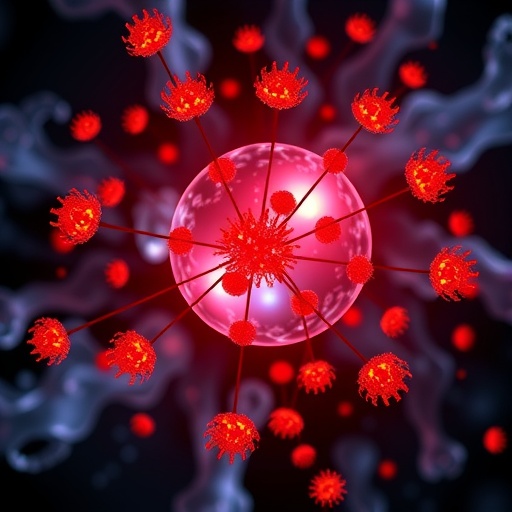In a groundbreaking study published in Translational Psychiatry, researchers have uncovered a conserved network of small RNA molecules that serve as a critical nexus between inflammation and pain signaling pathways in both mice and humans. This discovery not only deepens our understanding of chronic pain conditions but also opens up new avenues for targeted therapeutic interventions that could alleviate pain by modulating these RNA networks.
Inflammation and chronic pain are inextricably linked, but the molecular underpinnings of how immune responses translate into persistent pain sensations have remained elusive. The team led by Madrer, Bennett, Vaknine-Treidel, and colleagues embarked on a multidisciplinary approach combining cutting-edge RNA profiling, bioinformatics, and behavioral assays to map out the small RNA-mediated regulatory circuits involved in this complex process.
Central to their findings is the identification of a conserved set of microRNAs (miRNAs) that dynamically regulate gene expression in response to inflammatory stimuli. These miRNAs act as molecular switches, fine-tuning the expression of pain-related genes and modulating neuroinflammatory signaling pathways. The conservation of these RNA networks across species underscores their evolutionary importance and validates the use of murine models for translational pain research.
Using high-throughput sequencing and advanced computational models, the researchers cataloged a distinct signature of small RNAs that were consistently dysregulated in conditions of inflammation-induced pain. Intriguingly, many of these miRNAs were found to target mRNAs encoding key proteins involved in neuronal excitability, synaptic plasticity, and immune cell activation. This interplay suggests a sophisticated regulatory system whereby small RNAs orchestrate the cellular crosstalk necessary for pain sensitization.
The study further demonstrated that manipulation of these miRNA networks in animal models could significantly alter pain thresholds. By either enhancing or suppressing specific miRNAs, the researchers modulated inflammatory pain responses, which highlights these molecules’ potential as biomarkers and therapeutic targets. Such targeted approaches could outperform traditional analgesics by providing precision treatment with fewer side effects.
A particularly compelling part of the investigation involved cross-species validation. By comparing small RNA profiles from human patients with chronic inflammatory pain disorders to corresponding mouse models, the authors established a conserved molecular language that governs pain signaling. This translational relevance bolsters confidence in the clinical applicability of their findings.
Beyond miRNAs, the research also uncovered complementary roles for other small RNAs such as piwi-interacting RNAs (piRNAs) and small interfering RNAs (siRNAs) in modulating inflammation and pain pathways. Though less studied in this context, these RNA classes may add layers of post-transcriptional control that intricately shape the neuroimmune dialogue underpinning chronic pain.
The implications of these discoveries are vast. Persistent pain affects millions worldwide, often linked with debilitating inflammatory diseases like arthritis and neuropathies. Current treatments inadequately manage symptoms, with risks of addiction and tolerance. By illuminating the RNA-based regulatory network at the root of inflammation-induced pain, this research paves the way for novel RNA-targeted therapeutics designed to recalibrate dysfunctional signaling without dampening the immune system globally.
Moreover, these findings align with the burgeoning field of epigenetics and RNA biology, reinforcing how gene expression is intricately governed beyond DNA sequences. The small RNA molecules act as key epigenetic modulators, bridging environmental triggers such as tissue injury or infection to long-term changes in neuronal function and pain perception.
This study’s integration of molecular biology and neuropsychology offers a holistic framework for understanding how chronic pain emerges from the complex interplay of immune responses and nervous system plasticity. It sets a precedent for future inquiries exploring the RNA-mediated regulation of other neuroimmune disorders.
Further research is warranted to decode the precise mechanisms by which specific miRNAs and other small RNAs interact with target mRNAs and proteins in distinct cell types, including nociceptive neurons and immune cells. High-resolution spatial and temporal mapping of these interactions could inform the development of RNA-based diagnostics.
In clinical settings, profiling patients’ small RNA signatures might serve as a valuable tool to categorize pain phenotypes and predict responsiveness to emerging RNA-targeted interventions. Such personalized medicine approaches could revolutionize pain management strategies.
In summary, this seminal work by Madrer and colleagues elucidates a sophisticated and conserved small RNA network linking inflammation to pain signaling, highlighting the promise of RNA biology to transform our approach to chronic pain treatment. As the field advances, harnessing these tiny but powerful molecules may finally unlock relief for patients burdened by persistent pain worldwide.
Subject of Research: The role of conserved small RNA networks in linking inflammation to pain signaling mechanisms in mice and humans.
Article Title: Conserved small RNA networks link inflammation to pain signaling in mice and men.
Article References:
Madrer, N., Bennett, E.R., Vaknine-Treidel, S. et al. Conserved small RNA networks link inflammation to pain signaling in mice and men. Transl Psychiatry (2025). https://doi.org/10.1038/s41398-025-03779-5
Image Credits: AI Generated




